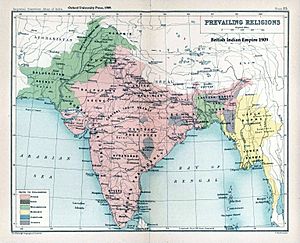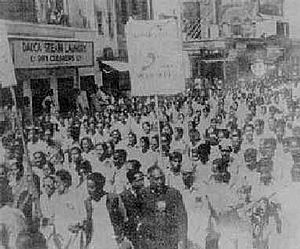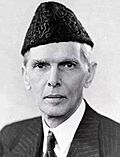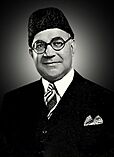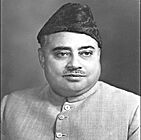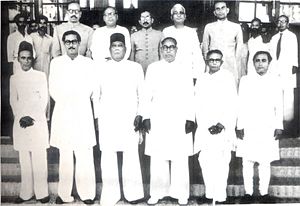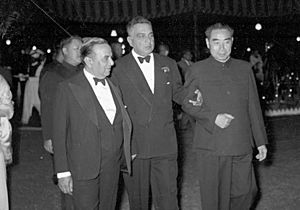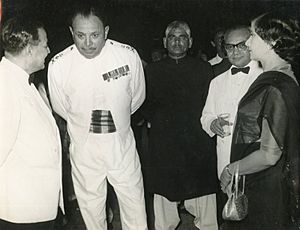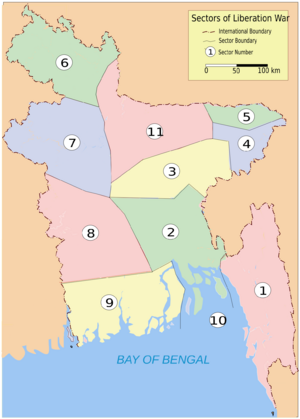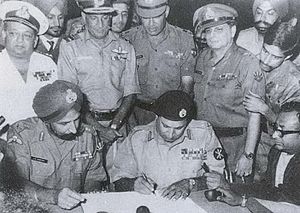History of East Pakistan facts for kids
The history of East Bengal and East Pakistan from 1947 to 1971 tells the story of how a part of Bangladesh became independent. This period started when British colonial rule ended in 1947 and the region became part of Pakistan. It ended in 1971 when East Pakistan fought for and gained its own independence, becoming the country of Bangladesh.
Contents
Early Years: 1947-1956
After Pakistan became a new country in 1947, it faced many challenges. One big problem was deciding what the official language should be.
The Bengali Language Movement
When Pakistan was formed, a big disagreement started about its official language. Muhammad Ali Jinnah, a key leader, wanted Urdu to be the only official language. This made many people in West Pakistan unhappy because their languages (like Punjabi and Sindhi) were not chosen.
In East Pakistan, people were even more upset. Most of Pakistan's population (about 54%) lived in East Pakistan, and their language was Bengali. Bengali and Urdu are both from the same language family, but they look and sound very different.
In 1948, Jinnah visited Dhaka and said that a country needs "one state language" to stay strong. But East Pakistanis did not agree. On February 21, 1952, students in Dhaka held a protest, asking for Bengali to be an official language too. Police fired on the crowd, and many students were killed. Later, a memorial called the Shaheed Minar was built to remember them. Because of these protests, the government eventually made both Urdu and Bengali official languages of Pakistan.
Political Challenges in Early Pakistan
In the beginning, Pakistan was held together by its strong leaders: Muhammad Ali Jinnah, known as the Quaid i Azam (Supreme Leader), and Liaquat Ali Khan, the first prime minister, known as the Quaid i Millet (Leader of the Community). Jinnah had a lot of power as the governor general.
When Jinnah passed away in 1948, Liaquat Ali Khan became the main leader. He wanted Pakistan to be a democratic country with a parliament. He also tried to find a balance between making Pakistan an Islamic state and keeping it secular (not based on religion). Sadly, he was killed in 1951 by people who disagreed with him.
After Jinnah and Liaquat were gone, Pakistan's government became unstable. Politicians often mistrusted each other and cared more about their own regions or groups than about the whole country. The group trying to write a constitution, called the Constituent Assembly, took almost nine years to finish it, and it was never fully used.
Khwaja Nazimuddin became prime minister after Liaquat. But the governor general, Ghulam Mohammad, was unhappy with Nazimuddin's handling of protests in East Pakistan. Ghulam Mohammad started to take more power. In 1953, he removed Nazimuddin and put the military in charge in Punjab, and took direct control of East Pakistan. He then chose Mohammad Ali Bogra as the new prime minister.
Later, Prime Minister Bogra tried to limit the governor general's power. But Ghulam Mohammad, with the support of the army, dissolved the Constituent Assembly and formed a new government. This showed how much power the army and civil servants had in Pakistan's politics.
United Front in East Bengal
In 1954, an election was held in East Bengal. A group called the United Front, which included parties like the Krishak Sramik Samajbadi Dal and the Awami League, won a huge victory. They won 223 out of 237 Muslim seats. This showed that people in East Pakistan wanted more control over their own region and were unhappy with West Pakistan's dominance.
On April 3, 1954, A. K. Fazlul Huq became the Chief Minister of East Bengal, leading the United Front cabinet. However, the governor-general, Ghulam Mohammad, quickly removed this government on May 30, 1954. He accused Fazlul Huq of trying to separate East Pakistan from the country. After this, the United Front itself started to break apart due to disagreements among its members.
Mid-Period: 1956-1966
The 1956 Constitution
In 1956, a new constitution was finally agreed upon. To create a better balance between West and East Pakistan, the four provinces of West Pakistan were combined into one large administrative unit. The 1956 constitution also said that Pakistan would be an Islamic state, meaning its laws should follow Islamic principles. The national parliament would have 300 members, with an equal number from both West and East Pakistan.
Suhrawardy's Time as Prime Minister
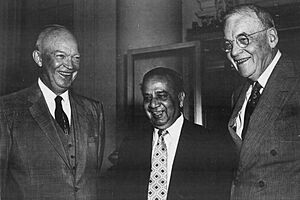
Huseyn Shaheed Suhrawardy from the Awami League became prime minister in September 1956. He was respected in East Pakistan and tried hard to get more self-rule and development money for his region. However, his efforts were not popular in West Pakistan. He also opposed keeping West Pakistan as "One Unit," which made him lose support from West Pakistani politicians. In 1957, President Iskander Mirza used his power to remove Suhrawardy from office. This period continued to be politically unstable.
The 1958 Military Takeover
On October 7, 1958, President Iskander Mirza declared martial law, which means the military took control. He got rid of political parties and cancelled the constitution. Mirza said this was temporary until a new constitution was written. However, on October 27, General Ayub Khan became prime minister and soon after, he sent Mirza into exile. Ayub Khan then removed many politicians and government workers, replacing them with army officers. He called his takeover a "revolution" to fix corruption.
The 1962 Constitution
In March 1962, Ayub Khan introduced a new constitution. This constitution gave almost all power to the president (Ayub Khan himself). The president could choose ministers without needing approval from the parliament. There was no prime minister. There was a National Assembly and two provincial assemblies, but their members were chosen by a special system called "Basic Democracies," not directly by all voters. The constitution declared Pakistan a republic, and the president had to be a Muslim.
This new constitution did not give much power to Bengalis in East Pakistan. It strengthened the central government under Ayub Khan. During Ayub Khan's rule, East and West Pakistan grew further apart. After Suhrawardy died in 1963, Sheikh Mujibur Rahman (often called Mujib) became the leader of the Awami League in East Pakistan. Mujib had been jailed before for wanting East Pakistan to have more freedom. He quickly made the demand for East Pakistan's self-rule a major issue in the country's politics.
Economic Differences
Between 1960 and 1965, West Pakistan's economy grew much faster than East Pakistan's. Bengali politicians complained that most of Pakistan's money from exports came from East Pakistan, especially from selling jute and tea. In 1960, about 70% of Pakistan's export earnings came from East Pakistan. But this money was often used to develop West Pakistan.
By the mid-1960s, West Pakistan was doing very well with its "Decade of Progress," which included improvements in farming and growing industries. Meanwhile, the living standards in East Pakistan remained very low. Bengalis were also upset that West Pakistan received most of the foreign aid because it was where the government was located. Mujib demanded that East Pakistan have its own separate money accounts and trade offices.
Towards Independence: 1966-1971
The Six-Point Movement
In 1966, Sheikh Mujibur Rahman announced his six-point plan for East Pakistan to have more political and economic self-rule. These six points were:
- Pakistan should be a true federation with a parliament elected by all adults.
- The central government should only handle defense and foreign affairs; all other powers should belong to the states.
- There should be two separate currencies for East and West Pakistan, or strong rules to stop money from moving from East to West Pakistan.
- States should have the power to collect taxes, and the central government would get a share from them.
- There should be separate foreign exchange accounts for each wing, and states should be able to trade with other countries.
- East Pakistan should have its own military or paramilitary force.
Mujib's plan went against President Ayub Khan's goal of keeping the country strongly united. Many West Pakistanis worried that Mujib's plan would break Pakistan apart. Ayub Khan saw these demands as a call for independence. After protests in Dhaka, Mujib was arrested in January 1968.
Political Unrest and Yahya Khan
Ayub Khan faced many problems in 1968, including poor health and an assassination attempt. Large protests and riots followed, especially in East Pakistan. A special court looking into Mujib's activities made people even angrier at Ayub Khan. On February 21, 1969, Ayub Khan announced he would not run for president again. The country was in chaos with widespread protests and strikes.
Finally, on March 25, Ayub Khan resigned and handed power to the army chief, General Agha Mohammad Yahya Khan. Once again, the country was under martial law. Yahya Khan said he would restore order and hold free elections for a new assembly to write a new constitution. He also made two important changes: he ended the "One Unit" system in West Pakistan, and he gave East Pakistan 162 seats out of 300 in the National Assembly, giving them a majority.
The 1970 Cyclone and Elections
On November 12, 1970, a terrible cyclone hit East Pakistan's coastal areas, killing as many as 250,000 people. General Yahya Khan's slow response and seeming lack of concern caused huge anger among Bengalis. Newspapers in Dhaka accused the Pakistani government of not helping enough. Mujib pointed out that West Pakistan had plenty of food, but East Pakistan had to wait for international aid. He said, "the feeling now pervades... every village, home, and slum that we must rule ourselves."
Yahya Khan had planned national elections for December 7, 1970. These were the first direct elections for the National Assembly in Pakistan's history. The Awami League in East Pakistan won almost all the seats (167 out of 169) in East Pakistan, showing how unhappy Bengalis were with the West Pakistani government. This meant the Awami League, led by Mujib, should have formed the government and Mujib would have become prime minister. However, the assembly never met.
West Pakistani troops in East Pakistan increased sharply, from 25,000 to about 60,000. Tensions grew, but Yahya Khan continued talks with Mujib. However, these talks failed. On March 23, Bengalis in East Pakistan defiantly celebrated "Resistance Day" instead of Pakistan's "Republic Day." Yahya Khan decided to use force to solve the problem. On the night of March 25, he flew back to Islamabad, and the military crackdown in East Pakistan began.
1971: The Fight for Freedom
On March 25, 1971, the Pakistan Army launched "Operation Searchlight" to crush Bengali nationalism. Within hours, a massive attack began in Dhaka, hitting places like the University of Dhaka and the old town. The army had lists of people to target and killed hundreds of Bengalis. Mujib was captured and taken to West Pakistan.
The Pakistan Army tried to hide what they were doing by gathering foreign journalists and expelling them. But some reporters, like Simon Dring, managed to report on the events. Estimates of deaths varied, but by the end of summer, around 300,000 people were thought to have died. Some estimates suggest that over one million Bengalis might have died during the nine-month struggle.
The West Pakistani press tried to deny these stories, saying the army was saving East Pakistanis. The government-controlled media called the civil war a small rebellion that was quickly being controlled.
After these terrible events, India strongly criticized Pakistan. Millions of East Pakistani refugees (between 8 and 10 million) fled across the border into India. India's Prime Minister Indira Gandhi decided to help the rebels in East Pakistan, but she did not officially recognize the provisional government of independent Bangladesh at first.
Pakistan and India then engaged in a propaganda war. Yahya Khan threatened war with India and said Pakistan had support from the United States and China. Pakistan also tried to calm the situation in East Pakistan by replacing the harsh military commander, Tikka Khan, with a more moderate one, Lieutenant General A.A.K. Niazi. A Bengali civilian, Abdul Malik, was made governor. But these actions were too late and did not change world opinion.
On December 4, 1971, the Indian Army, which was much stronger, launched a three-sided attack on Dhaka. It took them only 12 days to defeat the 90,000 Pakistani soldiers. The Pakistani army was far from its supplies, while the Indian Army was helped by East Pakistan's Mukti Bahini (Liberation Force), who were freedom fighters. On December 16, 1971, the Pakistani army in East Pakistan surrendered, and Bangladesh became a free country. This day is now celebrated as "Victory Day" in Bangladesh.
See also
- History of Pakistan (1947-present)


